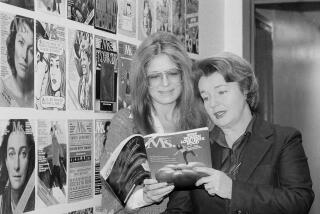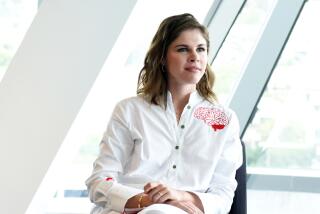‘New Woman’ Magazines Catch Advertisers’ Eye Amid Industry Slump
- Share via
NEW YORK — Magazine industry watchers saw more than a little significance in a recent announcement by Esquire Inc., chronicler of hairy-chested male accomplishment, that it will put out a bimonthly publication for women.
The publisher said it will bring out this summer New York Woman, a magazine for and about the city’s “accomplished and aspiring women.” The experts say its launch is another sign of success for a group of magazines that has recently prospered while much of the industry has languished in an advertising slowdown.
The group is sometimes called the “new woman” magazines, referring to their focus on the concerns of the younger and working women. The category usually includes the career-centered Working Woman, Working Mother, and Savvy; the health and fitness magazines Self and American Health; the largely political Ms., and Parents magazine.
Still Behind ‘Service’ Magazines
While these magazines still lag far behind the fashion and home-centered “service” magazines in profits and circulation, “their success with advertisers and ad agencies has been pretty spectacular,” says John Mack Carter, an oft-quoted industry observer and editor-in-chief of Good Housekeeping magazine.
Most of the publications have now been around for a decade, which, in a business with a 98% casualty rate, “is an impressive statistic by itself,” says Carol Taber, publisher of Working Woman magazine.
Working Woman, which turned 10 years old last month, has grown to a circulation of 770,000 by giving women advice on such practical matters as office memo writing and such abstruse topics as the wielding of corporate power. Recent articles included, for example, “How to get good results from problem people,” “Avoiding corporate culture shock” and “The ideal husband for a working woman.”
The magazine’s New York-based owner, Hal Publications, purchased it eight years ago in bankruptcy court reorganization. Last year, Working Woman’s revenue topped $20 million, up from about $10 million in 1982.
Of the magazines in the category, only Conde Nast’s Self, which maps the torturous path to leanness, has done better. Self’s sales topped $26 million last year, more than doubling since 1983, while its circulation passed the 1-million mark.
The magazines have succeeded by persuading advertisers that they are a sensibly priced way to reach a group of women who tend to be younger and more affluent than most, and don’t watch daytime television.
Prime-time television is too expensive, and, while general-interest magazines are more efficient on a cost-per-thousand readers basis, advertisers believe women pay closer attention to special-interest magazines.
“A lot of companies have been forgoing some more general-interest magazines to concentrate on smaller magazines, where a specialized subject brings you more reader involvement,” says Leo Scullin, a senior vice president at the Young & Rubicam ad agency in New York.
The magazines’ advertisers include, of course, food, cosmetics and apparel companies that provide the bread and butter for all women’s magazines. But the new-woman publications--in particular the career-oriented ones--have also attracted advertisers that have primarily pitched their products at men. Among these are financial service firms, automobile manufacturers and office-equipment makers.
Advertisers of office and business products--including office equipment and financial services--accounted for 52% of Working Woman’s ad revenue, for example. The No. 2 category is cosmetics, followed, by food, automotive products and apparel.
More Receptive
“Our goal in these ads is to try to reinforce, in an unintimidating way, messages we’re also trying to send in other media,” says Donald Holmes, marketing manager for the Sears Financial Network. The group, which includes the big retailer’s Dean Witter brokerage, Allstate insurance, Coldwell Banker real estate and Sears Savings Bank, began an ad campaign with the magazines this year.
The company has been encouraged by research showing that women are more receptive to ads for financial services than men.
“Men are often just as uninformed, but they’re not willing to admit it and seek out information,” Holmes said.
Some analysts believe that these specialized magazines can only gain advertising and circulation in the future, while the “Seven Sisters”--the venerable Ladies Home Journal, Better Homes & Gardens, Good Housekeeping and others--lose it.
The circulation of the traditional women’s magazines “has really peaked out, while the revenue growth hasn’t kept up with the growth of the advertising spending overall,” said David C. Lehmkuhl, a vice president at the N. W. Ayer & Co. ad agency in New York. “These new specialty magazines cater more to the needs of the younger women, and they’re bound to grow.”
Certainly, the new-woman magazines have already influenced the older publications, which carry more articles and columns on careers and fitness.
Working Woman Publisher Taber contends that not only the women’s service magazines, but also fashion magazines, are out of touch with today’s women.
“The women they show in those magazines--the cleavage, the open mouths, all that silly stuff--the women in our focus groups don’t identify with that,” she said.
But if the fashion magazines’ circulation growth rates don’t match those of the new-woman magazines, their hold on advertisers is unmatched. In advertising growth, such magazines as Glamour and Vogue far outstrip all competitors, often posting revenue increases of more than 20% a year.
Glamour, for example, the richest of the bunch, grew to revenue of $77 million in 1985 from $31 million in 1980. Average paid circulation reached 2.3 million in the second half of 1985, up about 20% in five years.
The financial success of the fashion books “is simply wild,” N. W. Ayer’s Lehmkuhl says.
Some of the new women’s magazines have also encountered a share of criticism.
Carter, the editor-in-chief of Good Housekeeping, for example, contends that the career-oriented magazines’ circulation levels should be higher, considering their age.
The circulation of the Seven Sisters ranged, in the second half of 1985, from Redbook’s 4 million to Better Homes and Gardens’ 8 million.
Diverse Population
The newer women’s magazines have not grown more, he says, because they have not found a way to appeal to the diverse population of working women with information that isn’t contained in older business magazines and the business sections of newspapers.
“That, increasingly, is the question they must answer,” he says.
Lehmkuhl contends that despite the magazines’ assertions to advertisers, their readership includes relatively few in high-income senior management and more women on the lower rungs of the corporate ladder. Polls by both of the widely used syndicated research agencies show that the median income of Working Woman readers is $32,000--about the same as that of mass-audience, celebrity-watcher Us, he noted.
Dispute Over Readership
“To say that they’re a good (advertising) buy because they reach upscale middle and top management is bogus,” he says.
He disputes, too, Working Woman’s contention that it should be considered a business magazine, and ranked No. 2 in the category in circulation after Business Week. Working Woman doesn’t really cover business the way Business Week, Forbes or Fortune do, he maintains, for fear of alienating an audience that isn’t quite as elite as those magazines’ readerships.
Two magazines in the group, Savvy and Ms., haven’t shared in the robust growth of the others. Savvy is subtitled “the magazine for executive women,” but some in the business wonder how many such women there are and whether a magazine of advice and features would interest them.
Savvy has recently offered, for example, stories on the role of humor in business success, tips on how to throw--and control--the power lunch and advice on how to handle “the office sycophant.”
“Surely by the time she’s a CEO, a woman doesn’t need a magazine to tell her what to do,” said Rena Bartos, senior vice president of J. Walter Thompson Co. in New York.
Ad Revenue Declined
The magazine, with current circulation of 350,000, saw its ad revenue decline 25% to $3.5 million between 1984 and 1985. While the decline continued in the first quarter of 1986, Kristin Norrgard, the magazine’s publisher claims that Savvy has attracted 45 new advertisers this year and is in the midst of a turnaround.
Ms., the feminist magazine, recently began a new advertising campaign amid continuing problems with circulation and advertising. Now entering its 15th year, Ms. saw ad revenue decline 11% to $5.63 million between 1984 and 1985.
Paid circulation, meanwhile, decreased 4% to 466,000 between 1983 and 1985.
‘Comfortable’ With Position
Patricia Carbine, the magazine’s publisher, says Ms. is “comfortable” with its financial position and is now emphasizing to advertisers its readership among the growing ranks of influential women.
Some analysts believe that the magazine suffers from a waning of interest in feminist issues and the fact that Ms.’s politics, while perhaps more mainstream today than in the past, still make some advertisers uncomfortable. “Whatever the editorial content, and it’s a fine product, there are a lot of advertisers who think it’s too left-wing and just don’t want to have anything to do with it,” Lehmkuhl says.
THE “NEW WOMAN” MAGAZINES READERSHIP Average paid circulation in thousands; 1985 figures are for the second half.
1985 1984 1983 Self 1,077 1,078 1,088 Working Woman 721 518 450 Working Mother 556 678 586 Savvy 330 305 296
Source: Fas Fax PAGES OF PAID ADVERTISING
1985 1984 1983 Self 1,182 1,157 672 Working Woman 1,236 1,291 813 Working Mother 882 871 548
Source: Publishers Information Bureau
More to Read
Inside the business of entertainment
The Wide Shot brings you news, analysis and insights on everything from streaming wars to production — and what it all means for the future.
You may occasionally receive promotional content from the Los Angeles Times.











